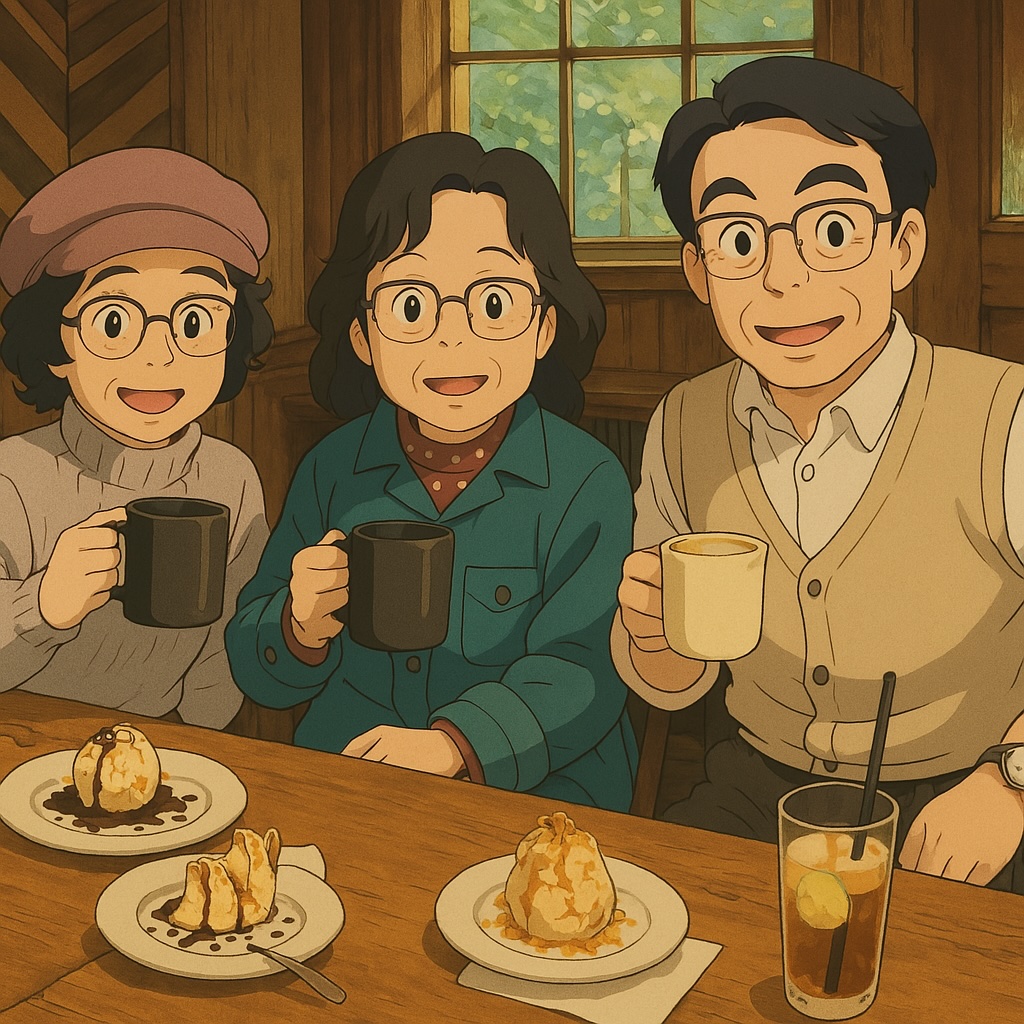Prompt to ChatGPT:
"Elaborate 吉卜力風格. Give some interesting examples and stories."
**吉卜力風格(Ghibli Style)**是由日本動畫公司「吉卜力工作室(Studio Ghibli)」所開創的一種獨特的視覺與敘事風格,以其細膩的手繪場景、富有生命力的角色、溫暖的色調、以及充滿奇幻與人文關懷的故事而著稱。以下是一些有趣的特色與故事例子:
1. 細膩的手繪場景與自然元素
吉卜力動畫最令人印象深刻的就是其精美的背景設計,尤其是大自然的描寫,例如:
《龍貓》(1988)——片中的鄉村景色是根據導演宮崎駿兒時生活過的日本昭和時期農村打造的,樹木、田野、溪流都極為細膩,甚至觀眾能感受到微風輕拂草地的感覺。
《魔女宅急便》(1989)——故事中的港口城市「柯里柯鎮(Kiki’s Delivery Service)」是以瑞典斯德哥爾摩和哥特蘭島為靈感,展現出歐洲小鎮的溫暖氛圍。
🎨 趣聞:吉卜力工作室的動畫師經常會親自到取景地進行寫生,甚至在《神隱少女》裡,油屋(湯屋)的設計靈感來自台灣九份與日本四國的道後溫泉。
2. 充滿靈魂的角色與動態細節
角色設計:吉卜力的人物通常不只是「善與惡」的簡單對立,而是有著複雜個性和情感的角色。例如《千與千尋》的無臉男,一開始是神祕的,但後來展現出孤獨與渴望被接納的情感,令人同情。
細膩的動作表現:
在《天空之城》中,當希達吃麵包時,她會小心翼翼地咬下,還會邊嚼邊閉眼品味,這種細節讓動畫中的角色更具生命力。
在《風之谷》,娜烏西卡撫摸王蟲時的手勢流暢又帶有真實的觸感,讓觀眾能感受到角色的情感。
💡 趣聞:《龍貓》中,小梅跌倒時的動作不是一般動畫的「誇張摔倒」,而是根據宮崎駿的觀察,真實還原小孩子摔倒後急忙爬起來的自然動作。
3. 食物與日常生活的療癒感
吉卜力的食物描寫充滿溫度,讓人垂涎欲滴,例如:
《天空之城》:巴魯做的「煎蛋吐司」,簡單卻令人食指大動。
《千與千尋》:白龍給千尋吃的「飯糰」,千尋一邊哭一邊吃,讓人感受到食物帶來的慰藉。
《霍爾的移動城堡》:培根與煎蛋在鍋中吱吱作響,超有現實感,很多人看完都想去做一份一樣的早餐。
🍳 趣聞:在《魔女宅急便》裡,琪琪收到的魚派上的魚骨頭,是動畫師特地去觀察真實的魚派後畫出的。
4. 奇幻與現實交織的世界
吉卜力的世界觀往往結合了奇幻元素與現實社會:
《千與千尋》:靈異世界的澡堂是基於日本傳統的神話觀念,神明會來這裡放鬆、洗滌。
《風之谷》:一個後末日世界,充滿巨型昆蟲與神秘生態系,寓意著人與自然的關係。
《紅豬》:一個有奇幻元素(主角是變成豬的飛行員),但又充滿1930年代飛行文化與歐洲氛圍的故事。
🌀 趣聞:宮崎駿喜歡飛機與飛行,因此他的作品中常常出現飛行器,《天空之城》、《紅豬》、《風起》都有極具美感的飛行場景。
5. 環保與人文關懷的主題
《風之谷》:講述人類對環境的破壞,以及大自然的反撲,影射了當時的核污染問題。
《魔法公主》:呈現工業發展與森林精靈之間的衝突,強調生態平衡的重要性。
🌍 趣聞:宮崎駿本人是環保主義者,他曾在吉卜力工作室種植樹木,並鼓勵使用環保材料。
結語
吉卜力的風格並不只是「可愛的手繪動畫」,而是一種能夠觸動人心、帶來情感共鳴的藝術。無論是細緻的背景、充滿靈魂的角色、還是對於食物與生活的描繪,這些元素共同構築了吉卜力的獨特魅力。
💭 如果你能進入吉卜力世界,你最想在哪部作品的場景裡生活呢?
The Ghibli Style is a unique visual and storytelling style pioneered by Studio Ghibli, a Japanese animation studio. It is renowned for its meticulously hand-drawn backgrounds, lively characters, warm color palettes, and narratives rich in fantasy and humanistic themes. Below are some interesting characteristics and examples of this beloved style.
1. Intricate Hand-Drawn Backgrounds and Natural Elements
One of the most striking aspects of Ghibli films is their beautifully detailed backgrounds, especially the depiction of nature. Examples include:
“My Neighbor Totoro” (1988) – The countryside landscapes in the film were inspired by the rural Japan of the Showa era, where director Hayao Miyazaki spent part of his childhood. The trees, fields, and streams are so vividly drawn that viewers can almost feel the gentle breeze.
“Kiki’s Delivery Service” (1989) – The port town of Koriko, where Kiki resides, was inspired by Stockholm and Gotland in Sweden, giving the film a warm, European atmosphere.
🎨 Fun Fact: Ghibli animators often travel to real locations for inspiration. For instance, the bathhouse in Spirited Away was based on Taiwan’s Jiufen and Japan’s Dogo Onsen.
2. Lifelike Characters and Attention to Movement
Character Design: Ghibli characters are rarely simply “good” or “evil.” Instead, they have complex personalities and emotions. For example, No-Face in Spirited Away starts as a mysterious figure but later reveals loneliness and a longing for acceptance.
Detailed Movements:
In Castle in the Sky, when Sheeta eats a piece of bread, she carefully bites it and chews with her eyes closed—such natural motions make the characters feel alive.
In Nausicaä of the Valley of the Wind, the way Nausicaä gently strokes the giant Ohmu conveys a genuine sense of touch and emotion.
💡 Fun Fact: In My Neighbor Totoro, when Mei falls, she doesn’t simply drop in a cartoonish way. Instead, the animators studied how children naturally fall and quickly get back up, making the scene feel incredibly authentic.
3. Comforting Depictions of Food and Daily Life
Food in Ghibli films is so well-animated that it often makes viewers hungry. Some famous examples include:
“Castle in the Sky” – The simple fried egg on toast that Pazu makes looks absolutely delicious.
“Spirited Away” – The rice ball scene, where Chihiro eats while crying, perfectly captures the comfort food can bring.
“Howl’s Moving Castle” – The sizzling bacon and eggs scene is so realistic that many fans have tried to recreate it at home.
🍳 Fun Fact: The herring pie in Kiki’s Delivery Service was based on real Swedish dishes. The animators even studied actual fish pies before drawing it!
4. A Blend of Fantasy and Reality
Ghibli films often mix real-world elements with fantasy:
“Spirited Away” – The mysterious bathhouse is based on traditional Japanese beliefs that gods visit special places to cleanse themselves.
“Nausicaä of the Valley of the Wind” – A post-apocalyptic world filled with giant insects and toxic jungles serves as a cautionary tale about humanity’s impact on nature.
“Porco Rosso” – Despite featuring a protagonist who has been magically transformed into a pig, the film is deeply rooted in the aviation culture of 1930s Europe.
🌀 Fun Fact: Hayao Miyazaki loves airplanes and aviation. That’s why many of his films, including Laputa: Castle in the Sky, Porco Rosso, and The Wind Rises, showcase beautifully designed flying machines.
5. Themes of Environmentalism and Humanistic Values
“Nausicaä of the Valley of the Wind” – Highlights the consequences of environmental destruction and how nature can fight back, reflecting concerns about nuclear pollution.
“Princess Mononoke” – Explores the conflict between industrial progress and nature’s spirits, emphasizing the need for balance.
🌍 Fun Fact: Hayao Miyazaki is an environmentalist. He planted trees around the Studio Ghibli office and encourages using sustainable materials.
Conclusion
Ghibli’s style is more than just “cute hand-drawn animation”—it is a heartfelt art form that deeply resonates with audiences. Whether through its detailed backgrounds, soulful characters, or loving portrayals of food and everyday life, these elements create a one-of-a-kind cinematic experience.
💭 If you could live in a Ghibli world, which film’s setting would you choose?
Prompt to ChatGPT:
請將照片轉換成吉卜力風格
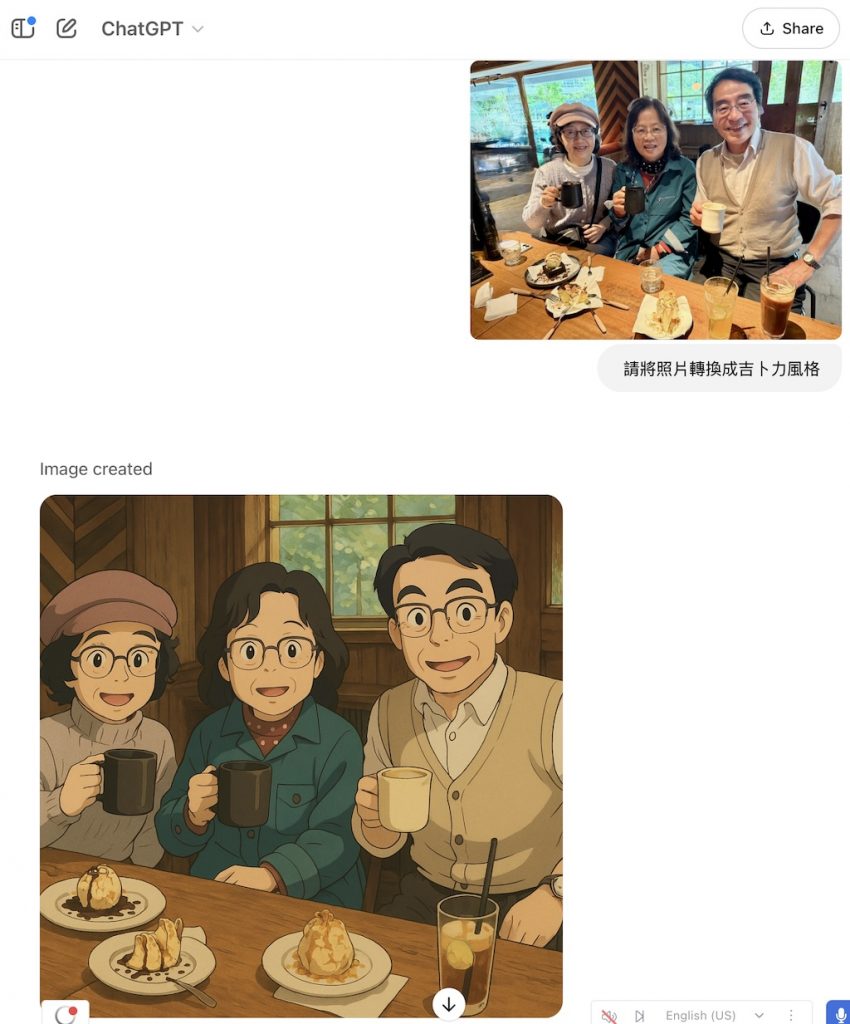
Screenshot showing ChatGPT converts my photo into Ghibli Style
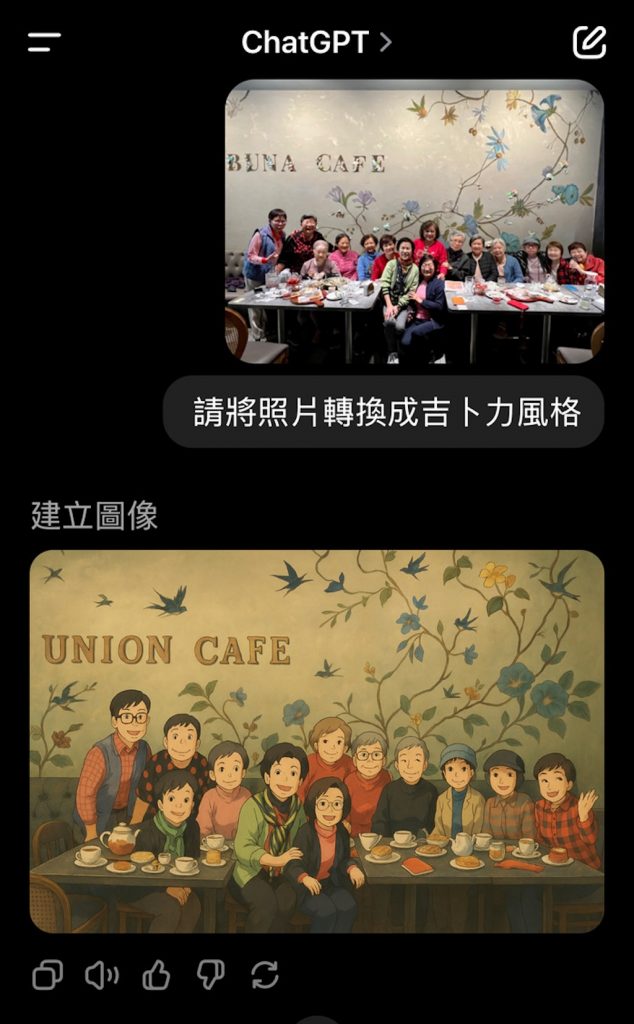
Screenshot showing ChatGPT converts my photo into Ghibli Style
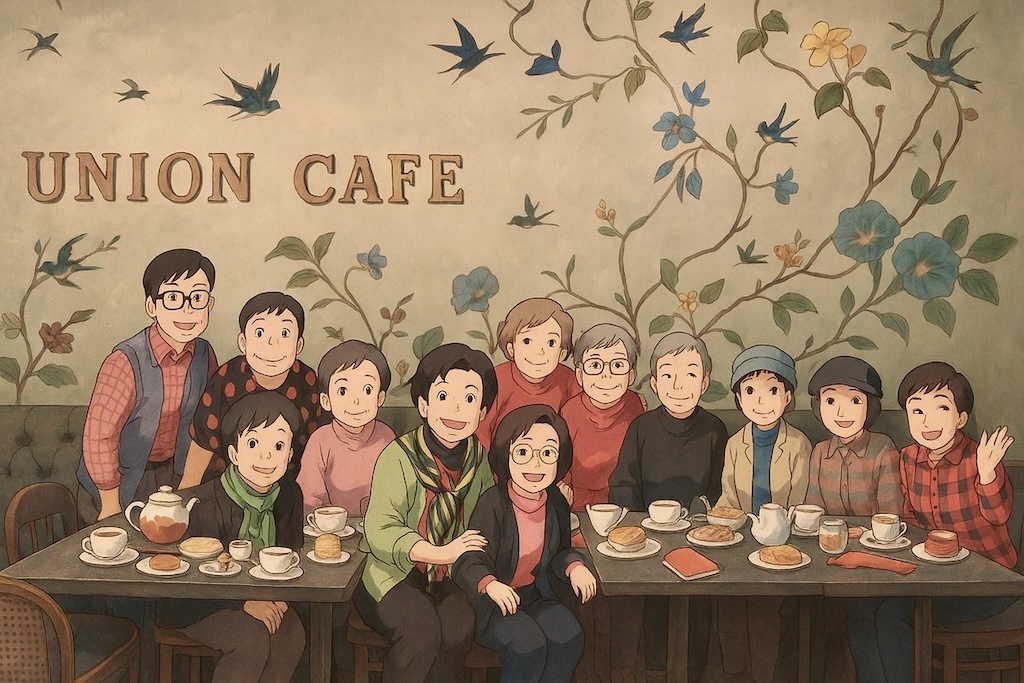
請幫我轉換成皮克斯動畫風格
ChatGPT converts my photos to Pixar's style
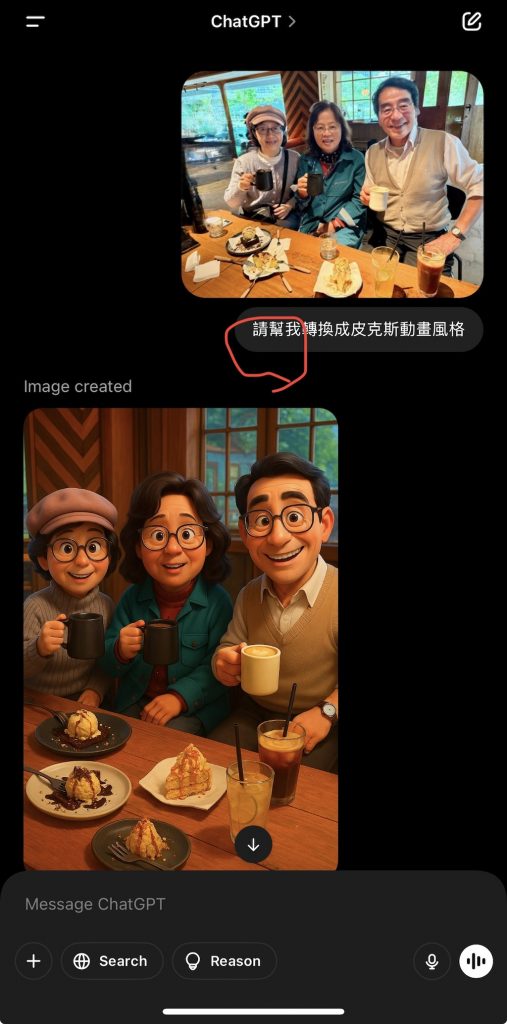
ChatGPT converts photo to Pixar's style
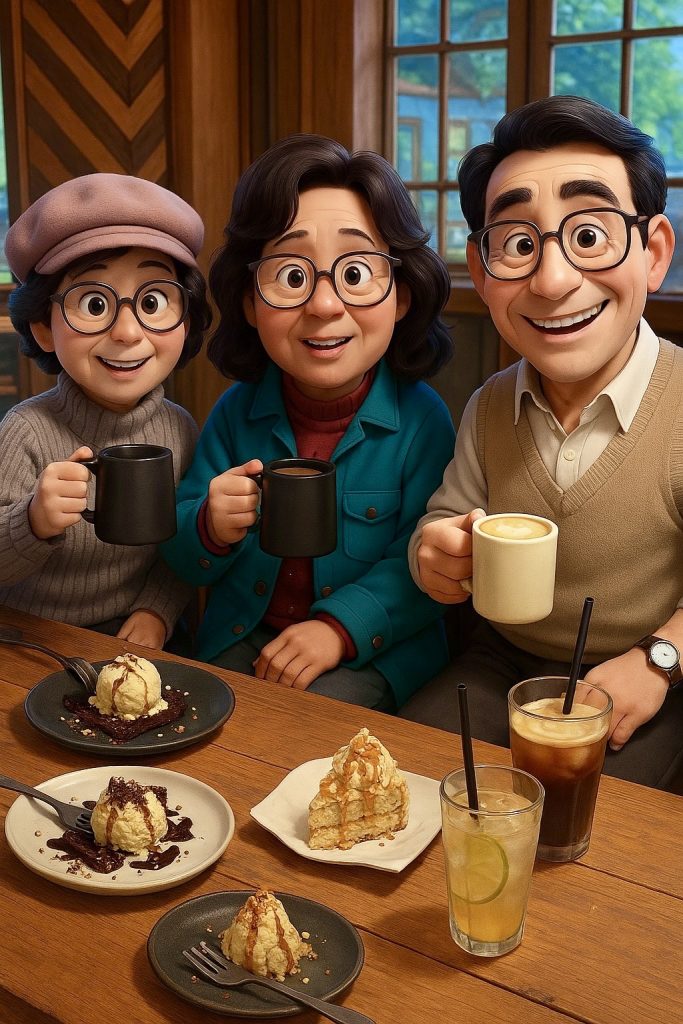
Pixar's style photo
Prompt to ChatGPT:
"Elaborate 皮克斯動畫風格. Give some interesting examples and stories, using Traditional Chinese."
當我們談到「皮克斯動畫風格」(Pixar Animation Style)時,不僅僅是在描述一種視覺風格,更是在談一種敘事哲學、角色深度與情感共鳴的藝術形式。皮克斯動畫擁有讓小朋友開心、大人落淚的魔力,這種「跨世代共鳴」正是它的靈魂之一。
🌟皮克斯動畫風格的特色:
1. 擬人化角色與情感共鳴
皮克斯擅長將非人類角色(玩具、汽車、怪獸、機器人、情緒等等)賦予強烈的情感與人格,觀眾很容易就能與角色產生連結。
🔹《玩具總動員》(Toy Story)是經典代表——玩具有靈魂、有羨慕、有自尊心、有對被遺棄的恐懼。
🔹《腦筋急轉彎》(Inside Out)直接把「情緒」擬人化,讓「樂樂」、「憂憂」、「怒怒」成為角色。這部片深入探討兒童的心理成長與失落,很少有動畫敢這樣處理情緒的複雜性。
2. 視覺風格精緻但非寫實
皮克斯的動畫不像某些動畫工作室追求超寫實風格,它的視覺風格偏向「程式化寫實」——場景與光影細膩,但角色設計誇張、可愛、有辨識度。
🔹在《料理鼠王》(Ratatouille)中,巴黎夜景與廚房場景非常細膩,但老鼠雷米的設計是大眼睛圓鼻子,兼具可愛與擬真。
3. 多層次敘事結構
皮克斯電影通常有雙主線,一條是表面情節(冒險、任務),一條是情感成長(自我認同、友情、家庭、失落等)。
🔹例如《天外奇蹟》(Up),你以為是冒險故事,但其實是在講述老人的喪偶之痛與重新學習敞開心房。
🎬 有趣的故事與細節:
✨1. 《瓦力》(WALL-E)——寂寞機器人的愛情詩
這是一部大膽的動畫,前40分鐘幾乎沒有對白,卻能透過肢體語言、鏡頭與配樂讓觀眾理解機器人瓦力的孤獨與渴望。當他遇見伊芙(EVE)時,那份純粹的愛情簡直像默片時代的浪漫電影。
→ 小細節:瓦力的眼睛設計靈感來自老式望遠鏡,這讓他看起來總是帶著一點「哀傷」與「好奇心」。
✨2. 《可可夜總會》(Coco)——音樂與亡靈節
這部片以墨西哥「亡靈節」文化為背景,結合音樂、家庭與死亡議題。最感人的是「Remember Me」那首歌,在主角米高唱給曾祖母可可時,勾起她對父親的記憶,那一刻無數人淚崩。
→ 小故事:皮克斯團隊實地去墨西哥小鎮做田野調查,甚至參與真實的亡靈節慶典,讓動畫中的場景、祭壇、音樂都非常考究。
✨3. 《靈魂急轉彎》(Soul)——關於生命的意義
主角是一位夢想成為爵士樂手的音樂老師,卻意外進入「靈魂的世界」。這部片探討人生意義、熱情與存在感。不是每個人都一定要找到「天命」,活著本身就是價值。
→ 彩蛋:電影中有大量爵士樂手致敬與真實錄音,每一段鋼琴演奏都是真人演奏後建模出動畫的。
🧠 一點點哲學味道
皮克斯動畫與迪士尼傳統的「王子與公主」不同,它更關心:
我是誰?
我的價值是什麼?
如何面對失敗與改變?
家庭與夢想怎麼取捨?
這些問題藏在幽默與可愛的外表下,才是皮克斯令人敬佩的核心。
如果你想創作類似風格的動畫或短片,可以從這三個方向開始思考:
給非人類角色一顆真誠的心。
讓「小故事」承載「大主題」。
給孩子歡笑,給大人思考。
—
想了解更多關於某部作品背後的創作故事或技巧嗎?我可以再深入聊聊~
When we talk about the Pixar animation style, we’re not just describing a visual aesthetic — we’re talking about a whole storytelling philosophy, emotional depth, and character-driven art. Pixar has a unique magic: it makes kids laugh and adults cry. This cross-generational emotional resonance is the soul of its work.
🌟 Key Features of Pixar’s Animation Style:
1. Anthropomorphized Characters & Emotional Resonance
Pixar excels at giving non-human characters (toys, cars, monsters, robots, emotions, etc.) strong emotions and personalities, making it easy for audiences to connect.
🔹 Toy Story is the classic example — toys with souls, envy, pride, and fear of abandonment.
🔹 Inside Out turns emotions themselves into characters. Joy, Sadness, Anger — each one represents part of a child’s mental development. It’s rare for an animated film to handle such complex emotional topics so directly.
2. Stylized Realism in Visuals
Pixar doesn’t chase hyperrealism like some studios. Instead, its visual style is stylized realism — backgrounds and lighting are detailed, while characters are cute, expressive, and highly recognizable.
🔹 In Ratatouille, Paris and kitchen scenes are breathtakingly detailed, but the rat Remy has big eyes and a cartoonish nose — a perfect blend of realism and charm.
3. Multi-layered Storytelling
Pixar films usually have two storylines: the outer plot (adventure, mission) and the inner journey (emotional growth, identity, friendship, family, grief).
🔹 Take Up — you think it’s an adventure story, but at its core, it’s about an old man dealing with grief and learning to open his heart again.
🎬 Fun Stories & Details:
✨1. WALL-E — A Love Poem of a Lonely Robot
This is a bold film. The first 40 minutes have almost no dialogue, yet through body language, visuals, and music, we deeply feel WALL-E’s loneliness and longing. When he meets EVE, it becomes a silent-era romance.
→ Fun detail: WALL-E’s eyes were inspired by old binoculars, giving him a look of constant curiosity and gentle sadness.
✨2. Coco — Music and Día de los Muertos
Set against the Mexican Day of the Dead, Coco weaves together music, family, and the meaning of legacy. The most emotional moment? When Miguel sings “Remember Me” to his great-grandmother Coco, reviving her fading memory of her father — a real tearjerker.
→ Behind the scenes: The Pixar team visited small towns in Mexico to research real Day of the Dead traditions. Everything from the ofrendas (altars) to the music was carefully crafted.
✨3. Soul — On the Meaning of Life
The protagonist is a middle school teacher who dreams of becoming a jazz musician but ends up in the “soul realm.” This film explores the meaning of passion, purpose, and existence. It suggests that you don’t need to find your “one true calling” — simply being alive is meaningful.
→ Fun fact: The piano scenes were animated based on real jazz musicians’ performances, creating realistic hand movements and rhythms.
🧠 A Touch of Philosophy
Unlike Disney’s classic “prince and princess” stories, Pixar cares more about questions like:
Who am I?
What gives my life meaning?
How do I cope with failure and change?
How do I balance family and dreams?
These questions are wrapped in humor and cuteness, but that’s what makes Pixar so profound.
If you’re thinking about creating an animation in this style, start with these 3 elements:
Give non-human characters a genuine heart.
Let a “small story” carry a “big theme.”
Make kids laugh, but give adults something to think about.
—
Want to dive deeper into a specific Pixar movie or explore how to create a short film in this style? I’d love to chat more!

